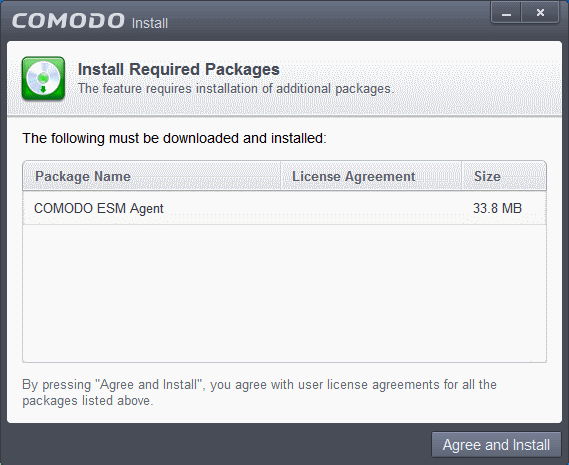How To Install Comodo Antivirus On Centos Rpm
Mahesh Dhamecha,clamav is. I have used it commandline, but there is a gui for it if one -really- must have one.I do not know which version of RHEL you are using, 5 or 6.If you activate the EPEL repo, then you can do a yum install clamav clamav-dbDoes the requirement you have for antivirus (perhaps from your customer or a larger organization, or security entity) demand 'real-time antivirus file protection' for things that are opened? Or are they looking for something that can be scheduled or ran on demand by a user?Clamav does not do persistent scanning but you can of course perform scheduled or on-demand scanning.NOTE: in 2009, there was a.
However, might show some more positive stats for clamav. I'd recommend researching more.Symantec has for Linux. Most of my customers are given the dreaded mandate of this. I and others with my organization have spoken with numerous Red Hat people, not just sales, but Red Hat Principal Engineers who have happened to have visited us directly (not just for that reason of course) and others we contacted by other means. No direct recommendations.

I posted a link to EPEL's clamav (previously in this discussion), and I've used it, and have seen mixed reviews good and bad. I've seen symantec used widely with one of my several larger customers. If Red Hat does have a recommendation besides placing clamav into EPEL, I'd really like to know about it as well.The EPEL source I posted has the rpm version, and it seems to be about the same version at clamav.net.
If one is going to build it from source, the clamav.net source version is rather straightforward, but takes a bit. The rpm at EPEL seems to be quicker and perhaps easier to install in numerous systems if an rpm is desired.
Hi Lindsey et al. I've gotten a basic ESET installation guide done:. There are some considerations to take related to SELinux which spawned another blog post:, but installation and use are otherwise painless, and I am very pleased with the ESET choice for linux antivirus (my own ease of use my lend itself from having prior exposure/experience with ESET I will admit, but it is extremely intuitive to use even for the unfamiliar imo).I can expand the installation guide into more direct/detailed information if you prefer (and I'm still planning on getting one done for the Server version as well, although I should note that ESET says their Desktop v. Server software is exactly the same protection etc. The only diff is that the Server version has a pretty cool remote management dashboard).

Sophos Antivirus For Linux
Please do let me know if the above is of any help and/or what else you'd find useful and I will certainly do what I can to oblige - enjoy!. Would Scap be a good solution here? Although not a virus checker its a scecuirty protocol that pulls together various security standards like STIG, CVE, CCE, CPE, OVAL, and XCCDF against which you system cna be scanned. The SCAP protocol was created by NIST, Red Hat are being slow to develop there own profiles by NIST provide a set here There is a good background article here http://www.admin-magazine.com/Articles/Checking-Compliance-with-OpenSCAP/. SCAP isn't a virus scanner and doesn't solve the same problem.SCAP is good for auditing configuration and security compliance from a configuration best practices (SCAP profiles) point of view and to check if servers are drifting from 'known good' configuration or have outstanding updates etc.AIDE (filesystem integrity monitoring) would be a much closer fit than SCAP scanning, but they still both don't provide the capability to identify known malware.Let me know how you go with OpenSCAP on Satellite Remmele. My memory is that it was a little tedious getting it up and running.

I've done some work setting up Satellite 5.6 and packages from the SCAP Security Guide (From the Satellite side, it was extremely simple, install the client tools (oscap scanner) and the satellite package, start scheduling scans.The content side can be more challenging. The SSG group is very active building profiles and has a mailing list with some helpful folks who can help with profiles. As an aside, it's also the upstream project for the US DoD STIG (Security Technical Implementation Guides). That said, I used the SSG project to build a profile based on a fairly popular internet RHEL benchmark in an afternoon.After that, it was figuring out how to distribute the content to the clients. I used both config files and RPMs, each have benefits and drawbacks, not sure if there's a clear recommendation there.
Problem with install.To the best of my ability I have verified that Comodo is not installed on this host, nor is any other antivirus program. When I attempt to install I receive an error and cannot continue.Host runs CentOS and all patches and upgrades are up to date.I have taken these steps:1) rpm -qa to view installed programs - verified no Comodo or other antivirus on the list2) Attempt to download and install rpm 64-bit Comodo antivirus from this page Receive this error during the install'Local file conflict between packages.Two packages provide the same file.This is usually due to mixingpackages from difference software sources.'